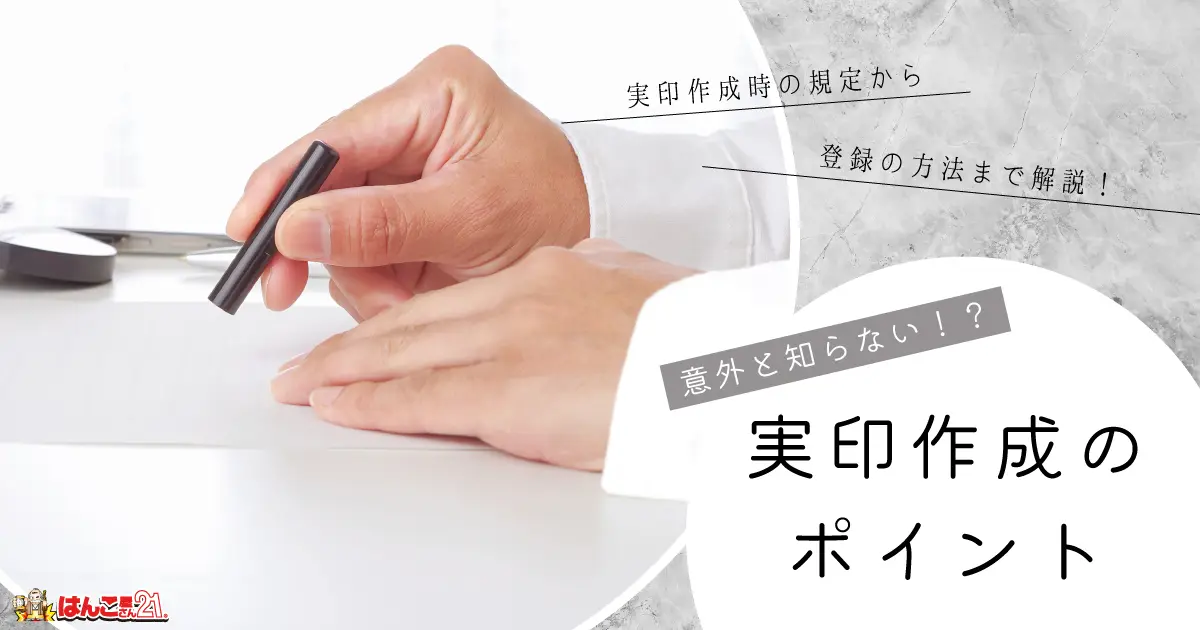When you become a working adult, you have the opportunity to enter into big contracts such as buying a house. A registered seal is required in such situations.
There are rules for creating a registered seal, so take this opportunity to learn the basics of creating a registered seal. In this article, we will explain the key points of creating a registered seal and how to register it. If you are considering creating a registered seal, please use this as a reference.
What is a registered seal?
A registered seal is a HANKO registered at a municipal office. By affixing your registered HANKO on a contract, etc., you can publicly prove that you entered into the contract with your own will.
Once you register HANKO, you can issue a HANKO registration certificate, which you may be required to submit when concluding important contracts.
The uses of a registered seal include real estate sales transactions, inheritance, the creation of notarized deeds, loan contracts, insurance contracts, automobile sales contracts, and the establishment of corporations.
Things to decide before making a registered seal
When making a registered seal, consider the size, font, engraving, and material in advance.
size
First, consider the size of the actual seal. There are rules regarding the size of registered seals that can be registered with local governments, so we will create a HANKO that meets the regulations set by the local government. The size regulations for registered seals stipulate that the HANKO must be larger than a square with one side of 8mm and fit within a square with one side of 25mm or less. If you create a registered seal in the range of 15mm to 18mm for men and 13.5mm to 16.5mm for women, you can make a HANKO that is easy to hold and stamp.
Engraving content
Choose whether to engrave your full name, last name only, or first name only.
For men, in most cases, the full name is engraved, and the large size of the HANKO provides enough space to engrave the full name.
Many women also engrave their full names, but because surnames sometimes change, there are cases, especially unmarried women, who engrave only their first names.
If you engrave only your name, there is a higher risk of forgery than if you engrave your full name, but you can reduce this risk by choosing a font that is difficult to read.
typeface
When it comes to the font of a registered seal, a higher priority is to ensure that it can be checked against the HANKO registration certificate even if the person cannot read it, rather than making it easy for a third party to read as required by the registered seal.
Therefore, there is no problem in choosing a typeface that is difficult to read. In fact, a typeface that is difficult to read can reduce the risk of counterfeiting.
Insobo and seal calligraphy are recommended because they have complicated shapes such as distorted character lines, and are considered to be auspicious typefaces.
Stamp material (HANKO material)
The requirements for a registered seal material that lasts for a long time are "durability" and "stampability".
Register your registered seal at the government office and use it for important procedures. If it is easily damaged or worn out, you will have to contact the person involved in the registration process or contract each time. You need to choose a material that is durable, can be used for a long time, and is soft and comfortable to use so that the ink won't rub off.
Ivory used to be the standard material for registered seals, but in recent years titanium has become the material of choice as it can be used semi-permanently.
You can also create a HANKO with your favorite design from unique materials such as water buffalo.
Points for creating a registered seal
Here are five points to keep in mind when creating a registered seal.
Check your budget
First of all, it is a good idea to check the market price of each stamp material (material for HANKO). In the case of ivory, which is the classic material for registered seals, the price range is from 20,000 yen to 70,000 yen. For titanium, the price ranges from 10,000 yen to 27,000 yen, for black buffalo from 4,000 yen to 18,000 yen, and for hontsuge from 7,000 yen to 15,000 yen. For women, natural stones such as Dutch water buffalo (7,000 yen to 18,000 yen) and red quartz (15,000 yen to 24,000 yen) are popular because they look gorgeous. There are also Agni (7,000 yen to 15,000 yen) made from eco-friendly wood.
Materials suitable for registered seals
Recommended materials for registered seals include titanium and natural black buffalo, which are popular among men, and Dutch buffalo and natural stone, which are popular with women. If the frame or text is removed after registering the registered seal, the seal will be considered to have changed and will no longer be usable, so we recommend that you choose a material that is as durable as possible.
popular among men
Titanium is becoming increasingly popular as a material for men's seals. Titanium is a durable material that is also used in golf clubs and medical equipment, and is the strongest and most durable material for HANKO. It has a solid feel both in appearance and feel.
Along with ivory, black buffalo is also traditionally chosen as the material for seals. It is durable because it uses the core of buffalo horn as its material, and the ink blends well with it, making it smooth to use when stamping.
Popular with women
Dutch water buffalo is a popular seal material for women. There are two types of Dutch buffalo: Dutch buffalo, each with a different black pattern (fu), and white Dutch buffalo, which does not have a fu.
Natural stone HANKO look like jewelry, and many women are attracted to the beauty of power stones.
However, it is less durable than titanium or buffalo, so it must be stored carefully.
In addition, demand for Agni has increased in recent years as a material that does not use animal-based materials. Wooden materials had the disadvantage of being prone to chipping and warping, but by forming a synthetic material with artificial resin, it has become possible to create HANKO that are both durable, impact resistant, and stretchable for easy imprinting. I did.
How long does it take to create?
To create a registered seal, request a HANKO specialist with a store or an online HANKO shop.
If you request stamp creation at Hanko Shop 21 shops, you can receive it the same day at the earliest, and on average the next business day. We recommend that you can consult with us face-to-face, express your needs, and be able to check the materials and sizes directly.
The delivery time varies depending on the engraving method of the HANKO, and the approximate delivery time is the next business day for machine engraving, 7 to 10 days for hand engraving by a craftsman, and 8 to 12 days for completely hand engraving. In the case of titanium HANKO, it takes about 5 to 7 days at the factory.
If you want to save money, buy a set.
If you want to purchase a registered seal at an even better price, we recommend purchasing a set. In addition to registered seals, you can purchase sets that include bank seals and registered seals at a cheaper price than buying them individually. If you are a corporation, you can also purchase a set of HANKO. Since registered HANKO are not the only seals used by corporations, purchasing a set should save you a lot of trouble later on.
How to register a registered seal
We will explain how to register the last created HANKO as a registered seal.
HANKO that can be registered
First, let's check the difference between HANKO that can be registered as registered HANKO and those that cannot. Once again, a HANKO that can be registered as a registered seal must be larger than a square with a side of 8mm and fit within a square with a side of 25mm. If you ask a company to make your HANKO, you won't be able to get it made in the wrong size, but it's a good idea to be aware of this.
HANKO that cannot be registered
HANKO that cannot be registered HANKO HANKO that have engravings other than the name on the seal, and those that are likely to be easily deformed, such as rubber stamps and killer whales. Registration may be refused even if the impression of your seal is unclear, so be careful about the method of stamping, such as laying out a HANKO mat before stamping.
HANKO registration process
The procedure for registering a HANKO is to go through the procedure at the local government office where you have your resident card. Fill out the necessary information on the HANKO registration application form available at the counter and submit it along with the HANKO you wish to register. Once your application is accepted, a HANKO registration certificate will be issued. A HANKO registration card is a card used to issue a HANKO registration certificate. By using this HANKO card, you will be able to apply for a HANKO registration certificate when it is required as a required document for an important contract.
What you need to register HANKO
Three items are required for HANKO registration: the HANKO to be registered, an identification card such as a driver's license, and the registration fee.
Person who can register a HANKO
Only people residing in Japan who are 15 years of age or older can register a HANKO. However, if you are a person under curatorship or a person under assistance whose legal activities are recognized, you can register a registered seal. Also, if foreign nationals have a resident card, they can register a registered seal using the same procedure as Japanese people.
summary
We have explained the points to consider when creating a registered seal. With a registered seal, there is no need for someone else to read the imprint of your seal. To prevent counterfeiting and misuse, we recommend choosing a design/engraving method that is as difficult to read as possible. I hope this article will be helpful in creating your registered seal.
 日本語
日本語 English
English 简体中文
简体中文 繁體中文
繁體中文 한국어
한국어 ไทย
ไทย Tiếng Việt
Tiếng Việt Indonesia
Indonesia Français
Français Español
Español Português
Português


